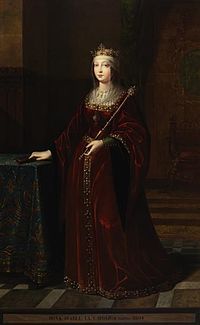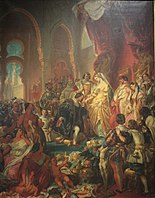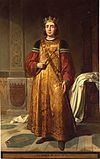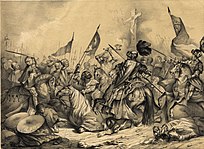Marta I
Template:KylarisRecognitionArticle
| Marta I | |||||||||
|---|---|---|---|---|---|---|---|---|---|
| The Conqueror | |||||||||
 Portait of Marta I by Vespasian artist Antonio Fauliano | |||||||||
| Queen of Paretia | |||||||||
| Tenure | 20 July 1541 - 3 November 1552 | ||||||||
| Coronation | 20 July 1541 | ||||||||
| Predecessor | Position Established | ||||||||
| Successor | Cássio of Herança | ||||||||
| Queen of Luzela | |||||||||
| Tenure | 16 May 1519 - 3 November 1552 | ||||||||
| Coronation | 16 May 1519 | ||||||||
| Predecessor | João II | ||||||||
| Successor | Cássio of Herança | ||||||||
| Born | 9 August 1498 | ||||||||
| Died | 23 March 1552 (age 54) | ||||||||
| Spouse | Mateus of Luzela | ||||||||
| Issue | Felipe V Infanta Sara Infanta Isabela | ||||||||
| |||||||||
| House | Azulejeiras | ||||||||
| Father | João II | ||||||||
| Mother | Boatriz | ||||||||
| Religion | Solarian Catholic Church | ||||||||
| Military career | |||||||||
| Allegiance | |||||||||
| Years of service | 1516-1552 | ||||||||
| Rank | Marechal-general | ||||||||
Marta I (Marta Teresa Rosália Boatriz da Azulejeiras da Luzela e Paretia; Born 9 August 1498), also referred to as Marta the Conqueror (Marta a Conquistadora), was the Queen of Luzela from 1519 to 1552, and later founder and Queen of Paretia from 1541 to 1552. She was born on August 9th 1498 into the House of Azulejeiras, Luzela's ruling family. Her father was king João II and Queen Boatriz the Catholic. She was the family's first born child, she had three other siblings, her brothers Lourenço and Cássio, and her sister Alba.
She was made heir by her father and when ascended to the throne would lead colonial and economic expansion in the Kingdom of Luzela. She would be credited with raising the quality of life and wealth of the Kingdom during her rule, as well as solidifying Catholic rule in Luzela. Later she would embark on her father's ambition of uniting the Paretian peninsula into one country.
Marta believed in the idea of pan-Paretianism, an idea given to her by her father on the basis of uniting the Paretian peoples into one strong nation. She would invade her neighboring states beginning the Paretian War, with Luzela allied with Visega, both kingdoms ruled by the House of Azulejeiras, pitted against Tosutonia, Mausoterra, and Esmeira. She would eventually succeed in conquering these kingdoms and ruling over the entire peninsula, afterward she would then unite the realms under her control into the United Kingdom of Paretia, and so becoming the first Queen of Paretia.
Early Life

Marta was born Marta Teresa Rosália Boatriz on 9 August 1498 to João II and Boatriz the Catholic, she was the first born. She would grow up with three younger siblings, brothers Lourenço and Cássio, and sister Alba. Her family lived under luxurious conditions in the Violet Fortress in Precea during a period of history where Luzela was making itself a notable power, especially in the Asterias, where under João II the first colonies of Luzela settled in Belmonte.
Marta's mother suffered from dementia during much of her childhood, who had episodes of her condition rather frequently, she was often kept away from public eye during much of her life during her husband and during Marta's rule.
Marta and her siblings were educated a great extent by their father, who, according to the Arquivo Real, told them of the ambition of conquering and uniting the Paretia peninsula. Lourenço died in a combat training accident at 15. They were educated extensively in politics, war stategy, and combat, which according to the Arquivo, were each eventually specialties of the other three siblings. Marta was said to be most talently skilled in politics the most, while her brother was said to be a master battle strategist and commander, and sister an excellent fighter.
In 1514 Marta had her first child to an unknown father, Felipe. In 1519 João II would die of old age. And, according to the Decree of Azulejeiras of 1516 by her father, Marta would be given the throne.
Early rule
In 1519 Marta I would be coronated in Precea. In 1520 Marta would marry Mateus of Coroa, but under her father's decree, would keep her house line moving forward with matrilineal marriage. Pan-Paretian throught arose in Paretia during João II's rule. Marta I's goal at the beginning of her rule was to consolidate Luzela as the dominant nation against the rising Esmeira.
The first actions as queen by Marta I would be the creation of the Ordem de Sotiras na Península, a military order designed to expand Luzelese influence in the peninsula. It also took part in keeping out Amendist reformist groups in Luzela from rising, it had begun to gain a small amount of popularity in Paretia. Marta I was a devout Catholic and her kingdom alongside Esmeira and Tosutonia began to subjugate any Amendist movements from appearing in the peninsula.
The order, known shortly as the Ordem Península, was headed by Lucio, Count of Chorto. Part of these efforts by the Ordem Península was to arrest of dozens of Amendist preachers in Luzela, as well as banning of Amendist works in the country.
Another action by Marta I was the expansion of the naval armada of Luzela, although her father had already done a great deal in funding the building of dozens of naval vessels, especially caravels. Marta wanted to focus on modernizing these ships and greatly added even more to the armada, Esmeira had begun to form their own large naval force too, and Marta wanted to keep ahead of them.
During her first year in power Marta made herself the first female Marechal-general of Luzela, giving her supreme command of her armies.
Colonial expansion

Marta I would visit the colonies of Luzela only once. But in her early rule she made a great deal of focusing on expanding the country's colonial foothold established by her father, especially in Belmonte, which was not very populated. Luzela wanted to compete with Esmeira and began to send settlers in 1521 to the colonies, beginning the greatly expand the settlements in the area. Marta devided the colonies into captaincies amongst Luzela's nobles, and colonization was mainly given to other outside groups.
The colonization effort in Belmonte was slow and was mainly delt with by local leaders and not much by the Luzelese crown itself. Although Marta I met with colonial leaders, as well as native representatives on multiple occasions, mainly to sort out issues in the colony. The crown also began to sent missionaries to the colonies to get converts in the local population.
The leaders in the colonized continued the slow building of the colonies, the terrain and environment made it difficult for colonial expansion for most of Marta's rule. The colonies began to fully establish trade routes with the home kingdom over time during Marta's rule.
Marta was greatly focused on expanding upon her nation's power at home on the peninsula still, and would give even more power to the local leaders of the colonies, including religious orders.
Conquest of Paretia
Moves onto Mausoterra

Marta I had already begun planning for taking over the peninsula for over a decade, her father João II had already had ambitions of doing so, and for Marta the task was handed to her upon his death. João II believed in Pan-paretianism, one of the oldest pan-national movements of it's kind, claiming that a united peninsula would make it easier to keep the influencing forces of the Etrurian states and Gaullica out. This idea was passed down to Marta I and she became a great believer in it. It had levels of support in all the nations of the peninsula, but especially in Luzela.
The land of Mausoterra, was the area between Luzela and Tosutonia. It is today located where the cities of Herança and Mausoleu are. During the 15th century many Luzelese began to settle in these areas alongside the Tosutons, making it around evenly split between the two peoples. Marta's father began to enact offerings for Luzelese to settle in these reaches of the peninsula. The Kingdom of Mausoterra was ruled by Tosutons, and by the 1500s became a minority in the area. The city of Herança would become a major Luzelese settlement in the region.
This area became the first target of Luzelese expansion, with the notion that the Luzelese must unify, in 1525 Marta I would send a warning to the Mausoterran King Joan Pau, to give the city of Herança independence or face invasion, they would accept the deal as Luzela was immensly stronger, and the Principality of Herança, which would be ruled by Marta's brother Infante Cássio would be founded. However this event would lead to an alliance between Mausoterra, Tosutonia, and Esmeira. Mausoterra was still mostly Luzelese and in 1527 an uprising in the city of Quiscarmá would be seen as justification for war by Marta I, and in 1528 she would invade Mausoterra and other small Luzelese-speaking kingdoms that had not been under the Luzelese crown, sparking the Paretian War.
Paretian War
The beginning of the war saw an alliance of states ruled by the House of Azulejeiras, Luzela, ruled by Marta I, Herança ruled by Cássio, and Visega, ruled by Marta's cousin Samuel Carlo II. Esmeira, Mausoterra, and Tosuton Confederation allied against Marta's armies. Her armies first conquered Casiovio, a small independence Luzelese kingdom.
By 1529 Mausoterra was mostly occupied by Marta's armies, Marta then set her sights on the Esmeiran city of Vallenoche, however her armies were defeated by a combined Esmeiran and Tosuton force, the First Battle of Vallenoche struck a major blow in Luzelese morale for the early years of the war. The Luzelese forces in Mausoterra would be forced to retreat back to Herança in 1530, after a few successful skirmishes by the Tosuton armies. In June 1530 Marta would be nearly captured during an Esmeiran ambush outside of Terilla, Marta would pull her armies out of Esmeira after this to resupply and rebuilt morale as it appeared the war was not in her favor at the time. The war on the peninsula began to slow down after the Luzelese retreat, in February 1531 in the colonies Marta's navy began to strike Esmeiran settlements, and began to blockade them and conduct occasional raids into the towns.
By 1532 Marta's younger siblings became more involved in the war, Cássio becoming one of Marta's high commanding officers, gaining the title "the Commander" after being able to hold off numerous attempts by Tosuton armies to reach Herança. He eventually became one of two generals who were Marta's second-in-command during the war, alongside General Don Felipe Sanches. Marta's younger sister, Infanta Alba also became a major player in the war effort, who throughout her childhood had become a skilled fighter and eventually became a Captain in the Luzelese armies fighting Tosuton forces. she gained the title "the Bloody" by Tosuton and Esmeiran forces after in March 1532 forces under her command captured Mausoterran King Joan Pau outside of Sigolus, followed by her personally executing him on the spot. Marta would use this event to boost morale in her own forces and instill fear into the Tosuton and Esmeiran armies.
The war at sea became critical to Luzelese victory, their armada had not been very much involved up until that point. The Esmeiran fleet was formidable and still controlled much of the Solarian coast. In 1533 the Luzelese Armada would sent it's fleet out to face the Esmeirans in the Solarian Sea. The Battle of October 1st as it was called, would be one of the bloodiest battles of the war and saw the Luzelese win a major victory and wipe out most of the Esmeiran fleet off the coast of Visega. The Luzelese fleet would then begin a blockade of Esmeira and block any attempt at Esmeiran supplies from reaching their colonial settlements. This battle coencided with an Esmeiran offensive into Visega and southern Luzela, Esmeiran armies led by King Ramón III saw opportunity in capturing the smaller kingdom of Visega, which had mostly been inactive in the war by that time.
The Esmeiran forces would leave Vallenoche and march into Visega in 1533 and capture the capitol of Visega, Etimal with little resistance. Marta's armies up north would head south to aid the Visegan forces which were severely outnumbered and retreating the new capitol at Pancarta. Marta would give a speech in April 1533 in Pancarta which proclaimed her ambitions of uniting the Paretian peninsula into one nation, stating that "the war is no longer about just the Luzelese, we have come a long way as the largest nation but all of the peoples of this land are threatened by this war, my ambitions are no longer to unite the Luzelese people, as Queen of Luzela I shall proclaim myself Queen of Paretia upon our victory. My father once wanted our peninsula to unite together, we may be at war right now but the rulers of the Esmeirans and Tosutons do not want this vision, they subjugate those who seek a greater Paretia and would rather become tools for the Vespasians and Gaullicans. I will unite this land into one United Kingdom!" This speech became the beginning of a Pan-Paretian view of Luzela's war, which is stated to be Marta's original intentions for years.
In 1533 the Marta's Luzelese and Visegan armies met the Esmeiran forces at Pico Chairo, Visega. The Battle of Pico Chairo saw the Luzelese able to cut off most of the Esmeiran armies from the command of Ramón III and his generals. The Esmeirans became trapped in the Chairo Valley where Visegan and Luzelese forces picked off their armies for nearly an entire day. The Esmeiran forces eventually surrendered and Ramón III would retreat back to Vallenoche. After the battle Marta asked for Esmeirans who were against Ramón III's rule to join her forces, which over 1,000 did. Marta's armies emassed a massive offensive into Esmeira and Ramón III would be killed during the fall of Vallenoche, with the kingdom in disarray and heirless, his wife Jimena II would become the ruler of Esmeira, though she had little power and it was mainly under military rule.
Esmeiran forces were routed across the country, and much of it was taken by 1535, when the Siege of Ocerto by Marta's armies began. The Siege would last for eight months, during which Marta freed all prisoners of the Esmeiran monarchy, trying to give the image that Luzela was liberating the peninsula.
The war in the south would continue to last for months as small pockets of Esmeiran resistance continued. Ocerto fell in November 1535, Jimena would surrender and Marta I would have her life spared if Jimena gave logistical and financial aid to her cause. Despite the monarchy's surrender, some Esmeirans kept fighting the war, and remaining forces of the Esmeiran army would unite and retreat northward across the Aventines into Tosutonia to meet with the Tosuton armies, which had been holding out for years. In 1536 Marta was consolidating her rule in Esmeira before focusing northward, Tosuton and Esmeiran forces decided to return to attacking Herança, this time due to much of Luzela's armies focused in the south, they were able to begin to lay siege to the city.

Cássio called for aid from his sister's armies in the south. Marta would decide boldly get her armies across the Eastern Aventines into Tosutonia during winter, which turned out to not do much damage to her forces as it appeared the weather in that year was warmer than usual. Marta would have her messengers send a threat to the King of Tosutonia, Jofre X, stating her plans to subjugate much of central Tosutonia while their armies were focusing on the capture of Herança, and threatened to sack and destroy the cities of Tosutonia and Esmeira that she had captured, including Ferracor, Ocerto, and Vallenoche.
Jofre X feared that they would lose everything if they continued the siege and decided it was better to fight in a last stand against Marta's armies, sending his armies back into Tosutonia to stop Marta's armies from destroying the cities of Mausoleu or Sigolus. Their armies would meet with Martas at the plains of Acaton just west of Sigolus. Here her armies had greatly resupplied and outnumbered the Tosuton forces and remaining Esmeiran troops. Jofre X's armies were also tired from the urgent retreat back to Tosutonia, which greatly weakened his forces for battle. The Battle of Acaton saw the Tosuton and Esmeiran forces crushed by Marta's army and the tailing Luzelese forces from Herança, cementing Jofre X's surrender and Marta's victory in the war.
Unification
After her victory in the war, Marta would first make members of her house rulers of Esmeira and Tosutonia. The Kingdom of Luzela became rich from the war from the resources gained from the war. It now became a large Euclean power, now in control of over 9 million people, it was one of the largest nations in Euclea.
Marta I's first major enactment after the war was the decentralization of the colonies under control of the individual Kingdoms, due to colonies speaking separate languages, the government allowed them to develop in their original colonial language, such as the Esmeiran settlements. This policy was known as Separados e Unidos. Marta would continue the expansion of colonies right after the end of the war.
Marta I would rule Luzela for the next four years, while it was seemingly in control of the entire peninsula as Esmeira and Tosutonia were ruled by her relatives and allies. In 1541 much of the threat of resistance against Luzelese rule was removed and dealt with in Esmeira and Tosutonia, by this time it was decided by Marta that Luzela and the rest of the peninsula should unify into one country. On July 20th 1541 Marta I would convene with the rulers of all of the realms of the peninsula, and declared herself the first Queen of Paretia and Luzela, here she restated her ambitions declared during the war to unite the Paretian peoples into one nation, and declared the creation of the United Kingdom of Paretia, which would be ruled by the monarch of Luzela and consisted of four Constituent Kingdoms, Luzela, Esmeira, Tosutonia, and Visega. The colonies would continue to have their decentralized rule by the constituent kingdoms.
Paretia would have a fairly centralized government, but Marta wanted to make sure the power of the four kingdoms was fair, and would personally oversee the creation of the governments of Tosutonia and Esmeira. After the creation of the united kingdom she would give up some of her power and ruled with much less of an iron fist as before.
Later rule
During the last years of Marta I's rule she came under increasing amounts of stress, her mother Boatriz died in 1544, an unnamed child of hers also had died during birth that same year. In 1546 her son Felipe became very distant with his mother, and eventually they had a falling out and Felipe would continue to live a life in the countryside. Despite these events she continued to rule effectively during the 1540s, which became the short-lived period known as the Short Paretian Peace, which Paretia had little conflict or troubles within the realms from 1543 to until around 1551.
In 1550 the first signs of Marta I's health decline became noticed, according to the royal archives she started to have symbols similar to that of her mother's dementia, despite this she continued to rule but the status of her heir was put into question, Marta's relationship with her son Felipe was not well and she was closer to her siblings. Even with this, Marta feared that giving rule to Cássio would lead to a conflict between her two younger siblings over the throne, Alba and Cássio both had massive military support, she feared possible civil war.
Marta met with her son in 1551 to attempt to come to terms with him, it however did not end well between the two.
Marta I became gravely ill in 1552, and as it appeared the illness would get worse, she wrote her final will and testament. On her deathbed, she gave it to her court and siblings, it stated that Cássio would be the heir and ruler to the throne until her son Felipe would return. She would die of her unknown illness on March 23, 1552 at age 54. Her final testament asked for her siblings to not struggle over the throne, however an insuing crisis for control would take place shortly after her death, becoming known as the Paretian Succession Conflict of the 16th Century.
Legacy
In Paretia Marta I is usually considered the most important historical figure in Paretian history, as she is considered the sole founder of the United Kingdom and the country of Paretia itself. In Luzela she is considered their most important monarch and political figure in their nation's history.

In Euclea she is considered among some of the most important figures in the continent's history, Marta I's action on pan-Paretianism makes her amongst the first political figures in Euclea to support a pan-nationalist ideology and create a nation that would transcend being centered around one ethnic group. This idea is seen later in countries such as Etruria or Scovern.
In Paretia she is also seen as the best monarchs in their nation's history, during her rule as Queen of Luzela and later Paretia, she was able to greatly enrich the country and raise standards of living.
Some aspects of Paretia, particularly outside of Luzela, however see her as a tyrant, as she would conquer the peoples of Esmeira and Tosutonia and subjugate them into being part of the Luzelese-ruled United Kingdom.
She is also popular as she a female monarch, in The Female Rulers of Euclea she is considered one of the leading historical female rulers in Euclean history.
In popular culture
Marta I is considered one of Paretia's most important historical figures and has inspired numerous works of art and pop culture in Paretia and abroad. Many works of art exist of Marta I, including paintings, sculptures, and busts. There are multiple films about her life, mostly originating from Paretia or Eastern Euclea. Marta I is also the subject of numerous Television series in Paretia and abroad. Marta I is a symbol of Paretia and Pan-Paretianism, the movement in support of keeping Paretia unified, she is also a symbol of women's rights movements in Paretia as well as nationalist Paretian movements. Examples of Marta I in pop culture include:
Marta I is a playable character in the Civitas game series by Enigma Games. She has the role as leader of the Paretian civilization in the game.
The film Conquérir, Marta is a Gaullican 1980 film about the life of Marta I.
Rainha is a 2004 Paretian film about the life of Marta I.
The miniseries Marta e os Irmãos is a 2013 Paretian TV miniseries that portrays Marta's rule as well as the insuing succession crisis after her death.





